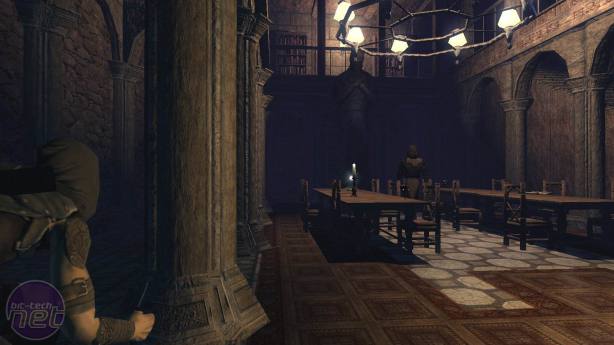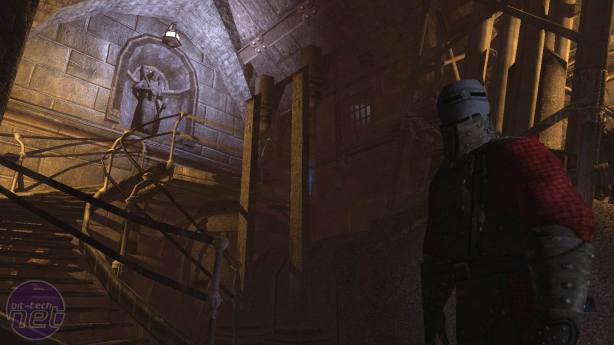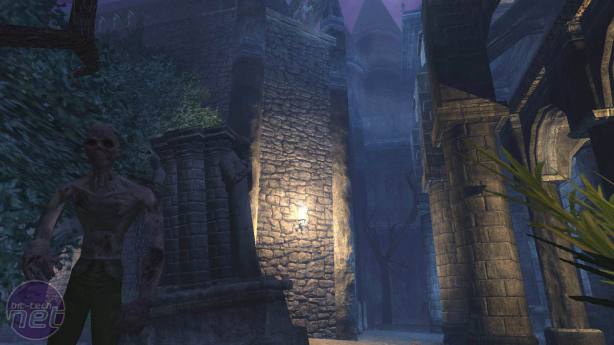
"I got a tip last night from my fence, Heartless Perry," Garrett mutters in the tutorial briefing. Immediately you're dragged back into his small and selfish world, where gold and glittery things are all that matters and people are merely an obstacle that need to be overcome. No mention that Garrett has basically saved the City twice, once from the Trickster and once from Karras. Nobody in the city cares, least of all Garrett.
Inevitably though, Garrett's light fingers end up grappling with something much bigger than himself. He's led back into working with the Keepers, an ancient organisation dedicated to "preserving the balance". So they're a bit like the UN, but with powers. Garrett's past affiliation with them, which has up to this point been a great boon for him given they're responsible for his thieving skills, now comes back to haunt him. He is used, framed and then hunted by Gamall, a monstrous Hag prophesised by the Keepers as a "Brethren and Betrayer".
It's a typically hokey story, but in a good way; providing an earnest contrast to Garrett's cynical, wisecracking personality. More importantly, it sends you off to explore some excellently designed - and often pretty darned scary locations.
Nowadays Deadly Shadows is known almost entirely for a single level, the Shalebridge Cradle, and it fully deserves its reputation as a masterpiece in horror design. But Deadly Shadows is an exceptionally weird and unsettling game across the board. This is a game where you must steal a magical crown from a race of creepy fish people, where you're hunted through the Keeper libraries by animated and immortal statues, where you're chased through the city by a terrifyingly powerful witch. It even forces you to navigate the cramped cargo hold of a ship crammed with zombies. You're nearly always running or hiding, and sometimes even those options are denied to you.
Interspersed between these moments of "Oh God it's GONNA FIND MEEEE!" are some absolutely fantastic heist missions. Three of these stand out in my mind. "The House of the Widow Moria" is set inside a huge mansion on a rocky outcrop in the middle of the ocean. The reason I remember it so well is because there's a staircase atop which a guard patrols, and if you shatter an oil bottle at the top of the staircase he slips and tumbles down it in a wonderfully slapstick fashion. "Of Brethren and Betrayers" beautifully inverts the Keeper Library from a place of sanctuary to a deathtrap for Garrett. Finally, the last mission, set inside an enormous museum, is just a wonderful location for nicking stuff, on a par with the Bank Heist level from the second game.
But it is and always will be the Cradle that comes out on top. So much has been written about it that it is pointless to go on about it too much, but there is one aspect of it that I'd like to highlight. What always got to me about the place wasn't the level design or the way the horror unfolds or all those hideous, twitching, creeping...things that prowl in its depths, but the twisted history of the place. It's a former orphanage that was converted into an asylum for the criminally insane, but the truly awful thing about it was that transformation was a gradual process. Hence there were vulnerable children living alongside psychopaths and sociopaths and inevitably this disastrous idea goes dreadfully wrong. It's genius writing. Horrible, nasty, genius writing.
It may have felt a little wonky, and the open city was a bit of a disappointment, but Ion Storm really understood what they were doing when they made Deadly Shadows. Their admiration for Looking Glass' work reveals itself at almost every level. The writing, the mission design, the atmosphere and those sudden moments of sheer panic-inducing terror are all beautifully woven together, and in these days of endless sequels and reboots created by third-party developers, it remains one of the strongest examples of how to respect the heritage of a game series while bringing your own memorable moments to it.
Inevitably though, Garrett's light fingers end up grappling with something much bigger than himself. He's led back into working with the Keepers, an ancient organisation dedicated to "preserving the balance". So they're a bit like the UN, but with powers. Garrett's past affiliation with them, which has up to this point been a great boon for him given they're responsible for his thieving skills, now comes back to haunt him. He is used, framed and then hunted by Gamall, a monstrous Hag prophesised by the Keepers as a "Brethren and Betrayer".
It's a typically hokey story, but in a good way; providing an earnest contrast to Garrett's cynical, wisecracking personality. More importantly, it sends you off to explore some excellently designed - and often pretty darned scary locations.
Nowadays Deadly Shadows is known almost entirely for a single level, the Shalebridge Cradle, and it fully deserves its reputation as a masterpiece in horror design. But Deadly Shadows is an exceptionally weird and unsettling game across the board. This is a game where you must steal a magical crown from a race of creepy fish people, where you're hunted through the Keeper libraries by animated and immortal statues, where you're chased through the city by a terrifyingly powerful witch. It even forces you to navigate the cramped cargo hold of a ship crammed with zombies. You're nearly always running or hiding, and sometimes even those options are denied to you.
Interspersed between these moments of "Oh God it's GONNA FIND MEEEE!" are some absolutely fantastic heist missions. Three of these stand out in my mind. "The House of the Widow Moria" is set inside a huge mansion on a rocky outcrop in the middle of the ocean. The reason I remember it so well is because there's a staircase atop which a guard patrols, and if you shatter an oil bottle at the top of the staircase he slips and tumbles down it in a wonderfully slapstick fashion. "Of Brethren and Betrayers" beautifully inverts the Keeper Library from a place of sanctuary to a deathtrap for Garrett. Finally, the last mission, set inside an enormous museum, is just a wonderful location for nicking stuff, on a par with the Bank Heist level from the second game.
But it is and always will be the Cradle that comes out on top. So much has been written about it that it is pointless to go on about it too much, but there is one aspect of it that I'd like to highlight. What always got to me about the place wasn't the level design or the way the horror unfolds or all those hideous, twitching, creeping...things that prowl in its depths, but the twisted history of the place. It's a former orphanage that was converted into an asylum for the criminally insane, but the truly awful thing about it was that transformation was a gradual process. Hence there were vulnerable children living alongside psychopaths and sociopaths and inevitably this disastrous idea goes dreadfully wrong. It's genius writing. Horrible, nasty, genius writing.
It may have felt a little wonky, and the open city was a bit of a disappointment, but Ion Storm really understood what they were doing when they made Deadly Shadows. Their admiration for Looking Glass' work reveals itself at almost every level. The writing, the mission design, the atmosphere and those sudden moments of sheer panic-inducing terror are all beautifully woven together, and in these days of endless sequels and reboots created by third-party developers, it remains one of the strongest examples of how to respect the heritage of a game series while bringing your own memorable moments to it.

MSI MPG Velox 100R Chassis Review
October 14 2021 | 15:04












Want to comment? Please log in.